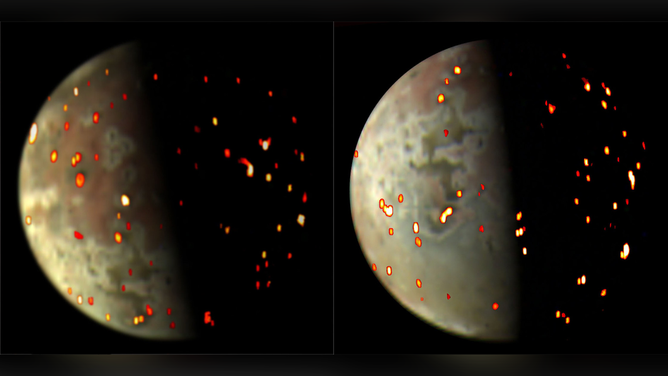NASA's Juno mission set to zoom past Jupiter's volcanic moon Io
Juno has so far performed 50 flybys of Jupiter and has been able to collect data on three of the four Galilean moons - the icy Europa and Ganymede and fiery Io.

This JunoCam image of the Jovian moon Io was collected during Juno’s flyby of the moon on March 1, 2023. At the time of closest approach, Juno was about 32,000 miles (51,500 kilometers) away from Io.
(NASA/JPL-Caltech/SwRI/MSSS. Image processing: Kevin M. Gill (CC BY) / NASA)
NASA's Juno spacecraft is set to zoom past Jupiter's volcanic moon Io on Tuesday on its way to the largest planet in the solar system.
Juno's flyby of Io is the closest to date at an altitude of about 22,060 miles, according to NASA.
Launched in 2011, Juno arrived at Jupiter on July 4, 2016. The extended mission, now in its third year to investigate the interior of Jupiter, the solar-powered spacecraft will also explore the ring system where some of the planet's inner moons reside, NASA said.
5 NASA IMAGES THAT COMMEMORATE JUNO'S 50TH ORBIT AROUND JUPITER
Juno has so far performed 50 flybys of Jupiter and has been able to collect data on three of the four Galilean moons - the icy Europa and Ganymede and fiery Io.
"Io is the most volcanic celestial body that we know of in our solar system," said Scott Bolton, Juno principal investigator from the Southwest Research Institute in San Antonio. "By observing it over time on multiple passes, we can watch how the volcanoes vary – how often they erupt, how bright and hot they are, whether they are linked to a group or solo, and if the shape of the lava flow changes."
SEE STUNNING PHOTOS OF JUPITER TAKEN BY NASA'S JUNO ORBITER

This composite image of Io was generated using data collected by the JunoCam imager aboard NASA’s Juno spacecraft during four flybys of the Jovian moon. The resolution of the images gets progressively better as the distance between the spacecraft and the moon decreases with each flyby.
(NASA/JPL-Caltech/SwRI/MSSS. Image processing, left to right: Bjorn Jonsson (CC NC SA), Jason Perry (CC NC SA), Mike Ravine (CC BY), Kevin M. Gill (CC BY) / NASA)
NASA said Io, which is slightly larger than our moon, is in constant turmoil.
Not only is Jupiter pulling at it gravitationally, but so are Europa and Ganymede. As a result, Io is constantly being stretched and squeezed, and those actions have led to the creation of lava seen erupting from volcanoes on the surface.
NASA said that Juno's sensors have provided plenty of new data on Jupiter's moons. In addition to the visible light imager JunoCam, the spacecraft's Jovian InfraRed Auroral Mapper (JIRAM), Stellar Reference Unit (SRU) and Microwave Radiometer (MWR) will study Io's volcanoes and how volcanic eruptions interact with Jupiter's magnetosphere and auroras.
WEBB TELESCOPE UNCOVERS MYSTERY OF ‘MINI-NEPTUNE’ AND ITS ATMOSPHERE

These composite views depicting volcanic activity on Io were generated using both visible light and infrared data collected by NASA’s Juno spacecraft during flybys of the Jovian moon on Dec. 14, 2022 (left) and March 1, 2023.
(NASA/JPL-Caltech/SwRI/ASI/INAF/JIRAM / NASA)
"We are entering into another amazing part of Juno’s mission as we get closer and closer to Io with successive orbits," Bolton said. "This 51st orbit will provide our closest look yet at this tortured moon."
Bolton added that during twin flybys of Io in December and next February, Juno will fly within 932 miles (1,500 kilometers) of the moon's surface.
"All of these flybys are providing spectacular views of the volcanic activity of this amazing moon," he said. "The data should be amazing."